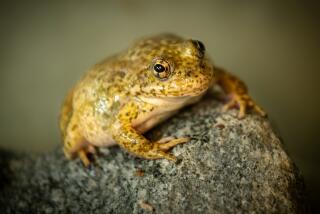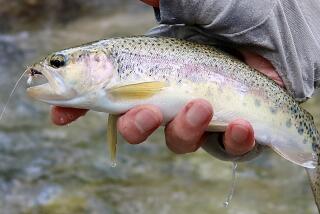Red-legged frogs may hop again soon in the Santa Monica Mountains
You’ll know it’s springtime in the Santa Monica Mountains when wildlife biologists start alerting curious visitors to keep their distance from the first red-legged frog reintroduction effort ever attempted in Southern California.
Biologists are gearing up to transfer fragile batches of California red-legged frog eggs from a tiny, isolated population in the nearby Upper Las Virgenes Canyon Open Space Preserve to separate streams in the Santa Monicas where the species has not been seen in nearly half a century.
“Our plan to bring them back to the Santa Monicas depends on the strength of this small remnant population in Upper Las Virgenes Canyon,” said Katy Delaney, a wildlife ecologist for the Santa Monica Mountains National Recreation Area, a unit of the National Park Service. “Those frogs only exist in a few hundred yards of a stream, and one catastrophic event could wipe them out.”
For hundreds of thousands of years, the largest native frog in the western United States thrived in deep year-round pools of water throughout Southern California and much of the state. The species scientists know as Rana draytonii has crimson undersides and can grow to 5 inches in length.
PHOTOS: Meet the animals that fascinated scientists in 2013
Since the 1960s, red-legged frogs have been decimated by fires, mudslides, pesticides, fungal infections and loss of habitat, as well as the appetites of carnivorous mammals and nonnative fish, bullfrogs and crayfish.
The federally listed threatened species has disappeared from 24 of the 46 California counties within its original range.
The rocky pools edged with mule fat and shaded by sycamores and oaks in the Santa Monica Mountains’ Ramirez and Solstice canyons are prime real estate for the relocation of the egg masses.
“Neither stream has nonnative fish, snails or crayfish, which can tear tadpoles apart,” she said. “So we’re cautiously optimistic about bringing back a population of breeding adult frogs in a portion of their historic range.”
In late February, a team of biologists from California State Parks, the National Park Service, the Santa Monica Bay Restoration Commission, the U.S. Fish and Wildlife Service and the U.S. Geological Survey Western Ecological Research Center will begin transferring the eggs to the streams.
To protect the eggs and tadpoles from voracious mammals and insects, they will be placed in porous bags and boxes anchored near the surface of the water. The tadpoles will be released sometime in the summer.
“I’d love it if in a few years we had red-legged frogs galore,” Delaney said.







